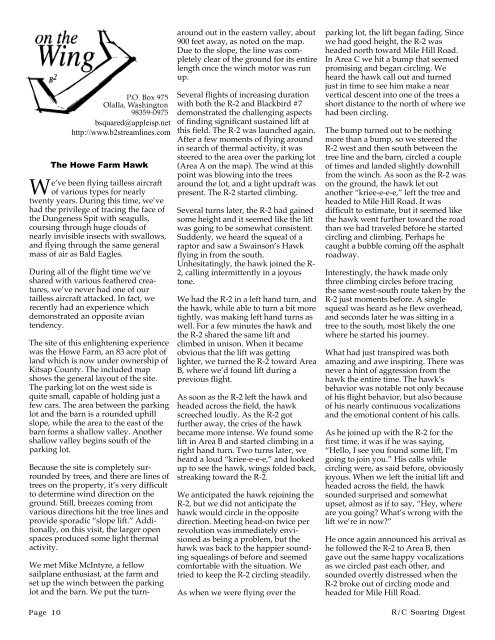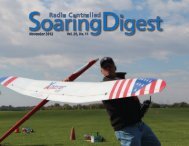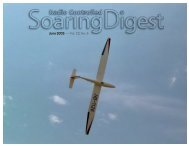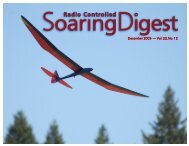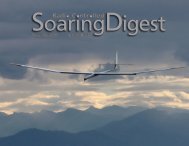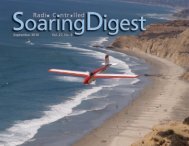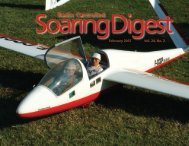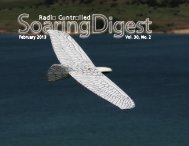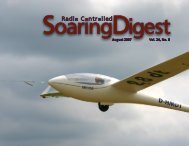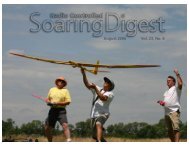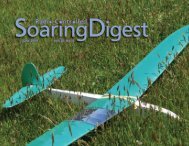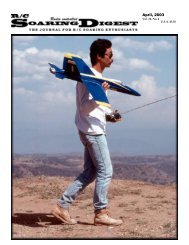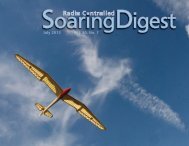October, 2002 - RC Soaring Digest - RCSoaring.com
October, 2002 - RC Soaring Digest - RCSoaring.com
October, 2002 - RC Soaring Digest - RCSoaring.com
You also want an ePaper? Increase the reach of your titles
YUMPU automatically turns print PDFs into web optimized ePapers that Google loves.
Page 10<br />
bsquared@appleisp.net<br />
http://www.b2streamlines.<strong>com</strong><br />
The Howe Farm Hawk<br />
We’ve been flying tailless aircraft<br />
of various types for nearly<br />
twenty years. During this time, we’ve<br />
had the privilege of tracing the face of<br />
the Dungeness Spit with seagulls,<br />
coursing through huge clouds of<br />
nearly invisible insects with swallows,<br />
and flying through the same general<br />
mass of air as Bald Eagles.<br />
During all of the flight time we’ve<br />
shared with various feathered creatures,<br />
we’ve never had one of our<br />
tailless aircraft attacked. In fact, we<br />
recently had an experience which<br />
demonstrated an opposite avian<br />
tendency.<br />
The site of this enlightening experience<br />
was the Howe Farm, an 83 acre plot of<br />
land which is now under ownership of<br />
Kitsap County. The included map<br />
shows the general layout of the site.<br />
The parking lot on the west side is<br />
quite small, capable of holding just a<br />
few cars. The area between the parking<br />
lot and the barn is a rounded uphill<br />
slope, while the area to the east of the<br />
barn forms a shallow valley. Another<br />
shallow valley begins south of the<br />
parking lot.<br />
Because the site is <strong>com</strong>pletely surrounded<br />
by trees, and there are lines of<br />
trees on the property, it’s very difficult<br />
to determine wind direction on the<br />
ground. Still, breezes <strong>com</strong>ing from<br />
various directions hit the tree lines and<br />
provide sporadic “slope lift.” Additionally,<br />
on this visit, the larger open<br />
spaces produced some light thermal<br />
activity.<br />
We met Mike McIntyre, a fellow<br />
sailplane enthusiast, at the farm and<br />
set up the winch between the parking<br />
lot and the barn. We put the turnaround<br />
out in the eastern valley, about<br />
900 feet away, as noted on the map.<br />
Due to the slope, the line was <strong>com</strong>pletely<br />
clear of the ground for its entire<br />
length once the winch motor was run<br />
up.<br />
Several flights of increasing duration<br />
with both the R-2 and Blackbird #7<br />
demonstrated the challenging aspects<br />
of finding significant sustained lift at<br />
this field. The R-2 was launched again.<br />
After a few moments of flying around<br />
in search of thermal activity, it was<br />
steered to the area over the parking lot<br />
(Area A on the map). The wind at this<br />
point was blowing into the trees<br />
around the lot, and a light updraft was<br />
present. The R-2 started climbing.<br />
Several turns later, the R-2 had gained<br />
some height and it seemed like the lift<br />
was going to be somewhat consistent.<br />
Suddenly, we heard the squeal of a<br />
raptor and saw a Swainson’s Hawk<br />
flying in from the south.<br />
Unhesitatingly, the hawk joined the R-<br />
2, calling intermittently in a joyous<br />
tone.<br />
We had the R-2 in a left hand turn, and<br />
the hawk, while able to turn a bit more<br />
tightly, was making left hand turns as<br />
well. For a few minutes the hawk and<br />
the R-2 shared the same lift and<br />
climbed in unison. When it became<br />
obvious that the lift was getting<br />
lighter, we turned the R-2 toward Area<br />
B, where we’d found lift during a<br />
previous flight.<br />
As soon as the R-2 left the hawk and<br />
headed across the field, the hawk<br />
screeched loudly. As the R-2 got<br />
further away, the cries of the hawk<br />
became more intense. We found some<br />
lift in Area B and started climbing in a<br />
right hand turn. Two turns later, we<br />
heard a loud “kriee-e-e-e,” and looked<br />
up to see the hawk, wings folded back,<br />
streaking toward the R-2.<br />
We anticipated the hawk rejoining the<br />
R-2, but we did not anticipate the<br />
hawk would circle in the opposite<br />
direction. Meeting head-on twice per<br />
revolution was immediately envisioned<br />
as being a problem, but the<br />
hawk was back to the happier sounding<br />
squealings of before and seemed<br />
<strong>com</strong>fortable with the situation. We<br />
tried to keep the R-2 circling steadily.<br />
As when we were flying over the<br />
parking lot, the lift began fading. Since<br />
we had good height, the R-2 was<br />
headed north toward Mile Hill Road.<br />
In Area C we hit a bump that seemed<br />
promising and began circling. We<br />
heard the hawk call out and turned<br />
just in time to see him make a near<br />
vertical descent into one of the trees a<br />
short distance to the north of where we<br />
had been circling.<br />
The bump turned out to be nothing<br />
more than a bump, so we steered the<br />
R-2 west and then south between the<br />
tree line and the barn, circled a couple<br />
of times and landed slightly downhill<br />
from the winch. As soon as the R-2 was<br />
on the ground, the hawk let out<br />
another “kriee-e-e-e,” left the tree and<br />
headed to Mile Hill Road. It was<br />
difficult to estimate, but it seemed like<br />
the hawk went further toward the road<br />
than we had traveled before he started<br />
circling and climbing. Perhaps he<br />
caught a bubble <strong>com</strong>ing off the asphalt<br />
roadway.<br />
Interestingly, the hawk made only<br />
three climbing circles before tracing<br />
the same west-south route taken by the<br />
R-2 just moments before. A single<br />
squeal was heard as he flew overhead,<br />
and seconds later he was sitting in a<br />
tree to the south, most likely the one<br />
where he started his journey.<br />
What had just transpired was both<br />
amazing and awe inspiring. There was<br />
never a hint of aggression from the<br />
hawk the entire time. The hawk’s<br />
behavior was notable not only because<br />
of his flight behavior, but also because<br />
of his nearly continuous vocalizations<br />
and the emotional content of his calls.<br />
As he joined up with the R-2 for the<br />
first time, it was if he was saying,<br />
“Hello, I see you found some lift, I’m<br />
going to join you.” His calls while<br />
circling were, as said before, obviously<br />
joyous. When we left the initial lift and<br />
headed across the field, the hawk<br />
sounded surprised and somewhat<br />
upset, almost as if to say, “Hey, where<br />
are you going? What’s wrong with the<br />
lift we’re in now?”<br />
He once again announced his arrival as<br />
he followed the R-2 to Area B, then<br />
gave out the same happy vocalizations<br />
as we circled past each other, and<br />
sounded overtly distressed when the<br />
R-2 broke out of circling mode and<br />
headed for Mile Hill Road.<br />
R/C <strong>Soaring</strong> <strong>Digest</strong>


